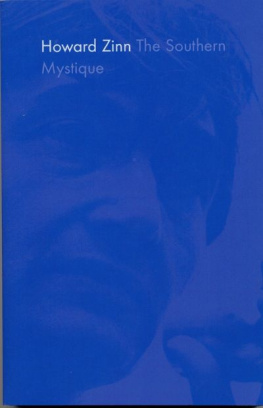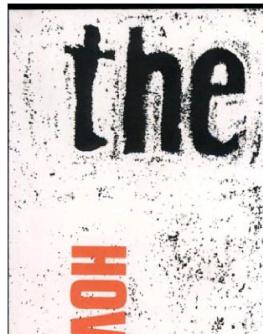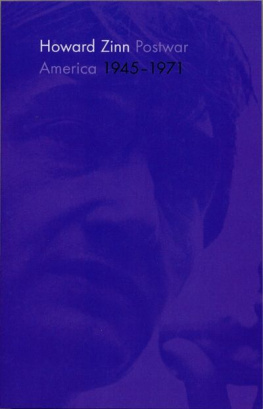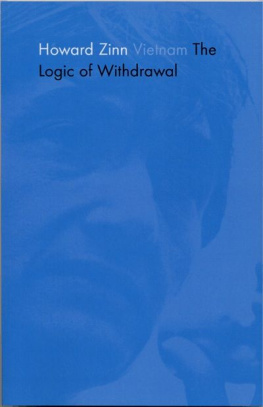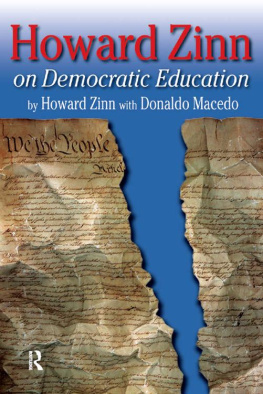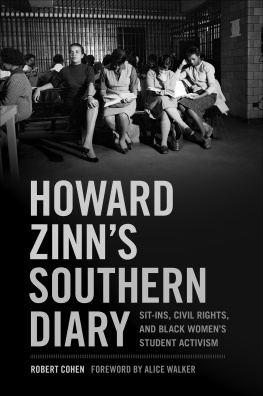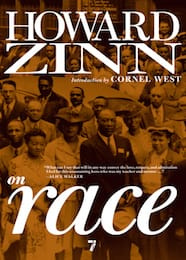Zinn - The Southern Mystique
Here you can read online Zinn - The Southern Mystique full text of the book (entire story) in english for free. Download pdf and epub, get meaning, cover and reviews about this ebook. year: 2011, genre: Art. Description of the work, (preface) as well as reviews are available. Best literature library LitArk.com created for fans of good reading and offers a wide selection of genres:
Romance novel
Science fiction
Adventure
Detective
Science
History
Home and family
Prose
Art
Politics
Computer
Non-fiction
Religion
Business
Children
Humor
Choose a favorite category and find really read worthwhile books. Enjoy immersion in the world of imagination, feel the emotions of the characters or learn something new for yourself, make an fascinating discovery.
The Southern Mystique: summary, description and annotation
We offer to read an annotation, description, summary or preface (depends on what the author of the book "The Southern Mystique" wrote himself). If you haven't found the necessary information about the book — write in the comments, we will try to find it.
Zinn: author's other books
Who wrote The Southern Mystique? Find out the surname, the name of the author of the book and a list of all author's works by series.
The Southern Mystique — read online for free the complete book (whole text) full work
Below is the text of the book, divided by pages. System saving the place of the last page read, allows you to conveniently read the book "The Southern Mystique" online for free, without having to search again every time where you left off. Put a bookmark, and you can go to the page where you finished reading at any time.
Font size:
Interval:
Bookmark:

THE SOUTHERN MYSTIQUE
Howard Zinn
Copyright 1959, 1960, 1963, 1964, and 2002 by Howard Zinn.
The Introduction appeared originally in slightly different form as The Southern Mystique in The American Scholar.
Part One includes a portion first published in slightly different form as A Case of Quiet Social Change in The Crisis, and brief passages from A Fate Worse than Integration were first published in Harpers Magazine.
Part Two includes a portion first published as Finishing School for Pickers in The Nation.
Part Three is an adaptation of Albany: A Study in National Responsibility, first published as a pamphlet by the Southern Regional Council.
To Fannie Lou Hamer
Contents
Teaching and living in Atlanta, Georgia, in the black community of Spelman College and its environs, observing the growing resistance to racial segregation in the city, I began to write about what I saw. My first published article, in Harpers Magazine, reflected my thoughts about the possibilities for change in what had seemed a society impenetrable and intransigent. When I traveled to Albany, Georgia, to write a report on the mass demonstrations of the black population in that city, I was forced to reflect further on the nature of the American South. As a white person close to black people in my college and in the movement, I felt that I was in a special position to reflect on white-black relations and their future. I began to reject the notion of a South totally different from the rest of the nation, and this book as an attempt to argue that thesis.
The Southern Mystique
P ERHAPS the most striking development in the South is not that the process of desegregation is under way but that the mystique with which Americans have always surrounded the South is beginning to vanish.
I was as immersed in this mystique as anyone else as I drove into Atlanta for the first time on a hot August night seven years ago. It was raining, and my wife and two small children awoke to watch the shimmering wet lights on Ponce de Leon Avenue. For the last full day of driving, the talk and the look of people were different. The trees and fields seemed different. The air itself smelled different. This was the mysterious and terrible South, the Deep South, soaked in blood and history, of which William Faulkner wroteand Margaret Mitchell and Wilbur J. Cash. White Atlanta had been ravaged and still knew it. Negroes had been slaves and still remembered it. Northerners were strangers, no matter how long they stayed, and would never forget it.
There was something about Atlanta, about Georgia, the Carolinas, that marked them off, as with a giant cleaver, from the rest of the nation: the sun was hotter, the soil was redder, the people blacker and whiter, the air sweeter, heavier. But beyond the physical, beyond the strange look and smell of this country, was something more that went back to cotton and slavery, stretching into history as far as anyone could rememberan invisible mist over the entire Deep South, distorting justice, blurring perspective, and, most of all, indissoluble by reason.
It is seven years later. I have lived these years inside what is often thought to be the womb of the Souths mystery: the Negro community of the Deep South. My time has been spent mostly with the warm and lovely girls in my classes at Spelman; but also with the earnest young men across the street at Morehouse, with the strangely mixed faculties of the Negro colleges (the white and the dark, the silent and the angry, the conservative and the radical), with the black bourgeoisie of college presidents and business executives, with the poor Negro families in frame houses across the street and their children playing with ours on the campus grass. From this, I have been able to wander out into the glare of the white South or to cross into those tiny circles of shadow, out of sight, where people of several colors meet and touch as human beings, inside the tranquil eye of the hurricane.
The Southern mystique hovered nearby even on yellow spring afternoons when we talked quietly to one another in the classroom. At times it grew suddenly dense, fierce, asphyxiating. My students and I were ordered out of the gallery of the Georgia General Assembly, the Speaker of the House shouting hoarsely at us. One nightmarish winter evening, I was arrested and put behind bars. Hundreds of us marched one day toward the State Capitol where helmeted soldiers with rifles and gas masks waited. A dozen of us sat-in at a department store cafeteria, silent as the manager dimmed the lights, closed the counter, and ordered chairs piled on top of tables all around. I drove four hours south to the Black Belt country of Albany, Georgia, to call through a barbed wire fence surrounding the County Jail to a student of mine who was invisible beyond a wire mesh window. It was in Albany also that I sat in the office of the Sheriff of Dougherty County who a month before had given a bloody beating with a cane to a young Negro lawyer. And nowhere was the mystique so real, so enveloping, as on a dirt road in the dusk, deep in the cotton and peanut land of Lee County, Georgia, where justice and reason had never been, and where the night before bullets had ripped into a farmhouse belonging to Negro farmer James Mays and exploded around the heads of sleeping children.
And yet, I can say now after living intensely in the Deep South in exactly those seven years when the South itself has lived most intensely, that the mystique is dissolving, for me, and for others. The South is still the most terrible place in America. Because it is, it is filled with heroes. The South is monstrous and marvelous at the same time. Every clich ever uttered about the South, every stereotype attached to its people, white and Negro, is true; a thousand other characteristics, complex and subtle, are also true. The South has not lost its fascination. But it is no longer mysterious. And I want to explain this by talking about those two groups who have been at the center of this mystery, the whites and the Negroes of the Deep South.
Although the darkness of the Negro physically suggests mystery, it is the white Southerner, oddly enough, who has been presented as the great national enigma. This, despite the whiteness of his skin, against which flaws and blemishes show up more easily, a whiteness unsullied by that admixture of Slavic and Latin blood found in the North, and kept homogeneous by the simple expedient of tossing over the wall in the night all offspring from black-white sexual encounter. The mystery of the white Southerner comes from a trait that he is presumed to possess in quantity and quality sharply distinct from that of everyone else. That trait is race prejudice.
Other white people, it is acknowledged, are color-biased. There is considered to be, however, something special about the quality of the white Southerners prejudice. The Yankee is rather businesslike in his matter-of-fact exclusion of the Negro from certain spheres of ordinary living. The British imperialist was haughty and sure of himself. But the violence, the passion, the murderous quality of the white Southerners feeling against the Negro has become a canon of American thought that is deep in our consciousness and our literature (and in European literature as well: Sartres La Putain respectueuse). And what is more significant, although the outward signs of this prejudice are clear enough, at its core, at the why of this crazy feeling, is a mystery.
When reporter John Bartlow Martin wrote
Next pageFont size:
Interval:
Bookmark:
Similar books «The Southern Mystique»
Look at similar books to The Southern Mystique. We have selected literature similar in name and meaning in the hope of providing readers with more options to find new, interesting, not yet read works.
Discussion, reviews of the book The Southern Mystique and just readers' own opinions. Leave your comments, write what you think about the work, its meaning or the main characters. Specify what exactly you liked and what you didn't like, and why you think so.

